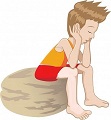Like most mothers, I constantly strive to achieve harmony in my home and help my children know the difference between right and wrong. Many parents, crèches, early education centers and primary schools use a ‘bold step’ or ‘bold chair’ where the child who has misbehaved must sit and take ‘time out’ from an activity until they are invited back by the parent or teacher. Even Supernanny on television is a big fan of the ‘bold step’ and ‘time out’ concepts.

I have never been comfortable with the parenting tool of ‘time out’ but I couldn’t see any alternatives. When I did use it, I always felt like it was a battle of wits between myself and my son. The scene would play out as follows: him acting in a manner which I felt warranted punishment, me telling him to go sit on the bold step, him refusing, me ordering him to go, him still refusing, me dragging him there, him getting up, me putting him back etc. etc. By this stage, both of us have lost our heads and neither is thinking rationally. What could be the possible learning point here for any child? I, for one, cannot see any benefit for either him or me. However, in the absence of an alternative, I continued periodically to force my son to take ‘time out’.
One of the things that made some difference was helping my son to try to control his anger. For example, when his sister annoyed him, his immediate reaction had been to lash out. I suggested counting to ten, taking a deep breath or walking away. However, if the behaviour continued, I would have then ordered him to the ‘bold step’ and we’d be back to the battle of wits.

For the past six months I have been on a parent coaching course with Koemba and as a result have had my eyes opened to alternatives when it comes to disciplining my children. Besides the helpful tools and insights on the course itself, one of the features is reading and reviewing books on parenting. In his book entitled ‘Unconditional Parenting: Moving from Rewards and Punishments to Love and Reason’, Alfie Kohn describes time out as ‘a version of love withdrawal when children are sent away against their will’. He believes that by removing the child, you might get the behaviour to cease but it is only a short term solution. It doesn’t examine what’s causing the behavior. He states ‘it is the child who engages in a behaviour, not just the behavior itself that matters’.
Kohn provides a number of alternatives to time out as follows:
1. If possible talk to your child and try to ascertain the reason for the behavior and explain why the behavior in question is not helpful;
2. If the child needs to first of all calm down, ask him/her if they would benefit from taking some time to themselves, e.g. in their room. It’s important that the child does not feel they are being forced to take time out;
3. If the child does not want to take time to himself/herself but it’s not appropriate to leave them where the behavior occurred, then the parent, as a last resort could remove the child and stay with them.
‘The Whole-Brain Child’ by Daniel Siegel and Tina Payne Bryson is a very interesting parenting book. It describes how a child’s brain develops and explains the difference between the left and right sides of the brain. When a child is upset, they are overwhelmed with right brain emotions and cannot employ left brain logic until they are calmer. The authors recommend that when a child is flooded with right brain emotions, parents should initially respond with their own right brains instead of trying to reason with the child which would mean using the left side of the brain. Responding with our right brain could mean making soothing sounds, being present for your child, listening attentively. I really like the following quote: “when parent and child are tuned in to each other, they experience a sense of joining together”. Once the child has calmed down, the parent can then apply logic and reason.
This book also explains how the upstairs and downstairs of the brain differ. Shortly after reading this section in the Whole-brain Child, I explained to my six year old son about “flipping the lid”. I showed him the illustrations in the book which were created specifically for children. They describe how our lids get flipped when we are cross or upset about something. It is only when we are calm, and our lids are back down, that we can be start to think clearly again. My son understood this message immediately. He was now able to put a label on how he felt when he got angry and wanted to lash out.
Since then my son has been learning to identify the signs when he is about to flip his lid. Even when he does lose his cool, he knows that he then needs to take time to himself until he calms down. He is effectively taking ownership of his own time out instead of me forcing it on him. Sometimes I just say, “Maybe you should go upstairs until you calm down” but most times he just goes to his room without any prompting. He then returns when he decides he is calm, not when I tell him to. That could be after two minutes or anything up to ten minutes later. When he returns we discuss what caused him to lose his cool, how he could have handled the situation differently, how he would likely deal with a similar scenario in the future, how he felt when he flipped his lid, how he feels now and how he thinks others involved in the incident felt.
 While my 6 year old son is happy to go off on his own until he calms down, my 4 year old daughter takes a different approach. When she is upset and has flipped her lid, she wants me to stay with her while she calms down. She often wants me to hold her while she does this. Maybe, over time, she will follow her brother’s example and go to her room, but for now having me there is helpful for her. So, where an argument comes to a head between the two of them, he takes off to his room to calm down and she stays with me. When he returns with his lid back down and when she is calm again, we discuss the argument in a rational and non judgmental way. We all learn and grow from these experiences.
While my 6 year old son is happy to go off on his own until he calms down, my 4 year old daughter takes a different approach. When she is upset and has flipped her lid, she wants me to stay with her while she calms down. She often wants me to hold her while she does this. Maybe, over time, she will follow her brother’s example and go to her room, but for now having me there is helpful for her. So, where an argument comes to a head between the two of them, he takes off to his room to calm down and she stays with me. When he returns with his lid back down and when she is calm again, we discuss the argument in a rational and non judgmental way. We all learn and grow from these experiences.
It has been amazing seeing my son and daughter develop in this way, taking control of their own emotions. In fact, my son recently said to me,
“Mam, you’ve just flipped your lid”.

That stopped me in my tracks and when I’d calmed down, I thanked him for pointing that out to me and explained that everyone loses their cool from time to time.
The bold step no longer features in my house. In fact my daughter has never been on it and I don’t envisage ever using it for my 2 year old son. It’s great to know that there are alternatives to smacking children or using ‘time out’. It’s up to every parent to find the one that best fits their family and their quest for harmony in their home.
Marie Reilly
Mother and Trainee Parent Coach
April 2012


What a lovely reality Marie Congratulations on sitting under Val’s teaching. I wish you every blessing as you use the same skills in your relationship with yourself as well as others with whom you walk closely. My way of being as a parent, counsellor and life giver has been transformed since I did Val’s coarse a couple of years ago. Your have been immersed in pure gold! Enjoy !
Hi Joan, many thanks for your lovely comments. I do believe my parenting journey has been greatly enriched by meeting Val.
Marie, what an inspiring article!!! With your permission I would like to share this with my friends and colleagues.
I also have the opportunity to journey with Koemba on the path of parent coaching and the learning is ongoing and rewarding.
Hi Anca, please feel free to share the article. I’m very happy to share what I am learning on the course and from other participants like yourself! Thanks.